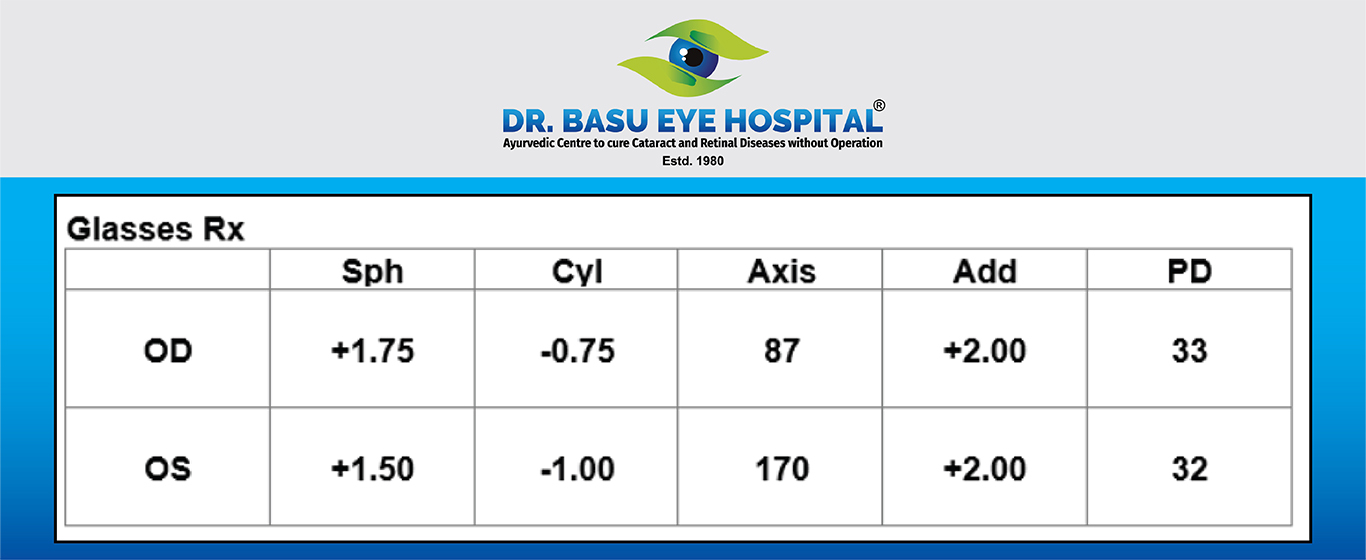
Understanding Eye Prescription can be a bit tricky, but with a basic understanding of the units used to measure focus power, you can decode your eye prescription without any trouble. After a series of vision tests, your eye care professional will present you with an eyeglass prescription, a detailed document outlining the specific corrections needed for your vision. To simplify this complex document, we’ve outlined some key components of an eyeglass prescription that will help you understand your eye power more easily.
Sphere (SPH): SPH in a prescription stands for sphere, which is required to correct nearsightedness or farsightedness. The spherical number on your eyeglass prescription tells about the lenses needed to correct your vision and is measured in diopters. The minus sign (-) denotes nearsightedness, and the plus sign (+) signifies farsightedness.
Cylinder (CYL) and Axis: For those with astigmatism, where the eye curvature is impacted, and it becomes more like an egg or football. This causes distorted vision at both near and far distances. Here, the CYL number defines the degree of lens power that could correct the irregular shape of the cornea, whereas the axis is between 1 degree and 180 degrees, which indicates the angles where the cylindrical power should be placed in eye lenses.
Pupillary Distance (PD): This is also known as interpupillary distance, which is measured in millimeters. Pupillary distance is measured between the centers of the pupils in both eyes. This helps ensure that the lenses align correctly with the eyes for optimal focus. OD stands for oculus dexter and OS stands for oculus sinister used in eyeglass prescriptions to indicate the right and left eyes, respectively.
What do diopters mean in a vision test?
Diopters are measurement units that indicate a lens’s optical power, such as in eyeglasses or contact lenses. They are used to calculate a lens’s focusing strength and can be seen in the eyeglass prescription in the “Sphere” or “Cyl” column.
Types of Diopters :
Positive diopters: in a prescription indicate that the wearer is suffering from hypermetropia. You can also say that the person suffers from farsightedness or longsightedness and needs correction to see things up close.
Negative diopters: in a prescription indicates that the person has Myopia. He has issues while seeing objects that are placed at a distance.
Understanding these terms is essential to understand your eye prescription because they help you understand which is the right eyewear you should go for in correcting your vision. The precision of this prescription also helps you choose the right eye wear and keeps you away from choosing eyewear of incorrect specifications that could lead to eye strain and headaches. Therefore, patients must understand their prescriptions to make instructed choices about their corrective eyewear and affirm its precision during dispensation.
Why is a vision test required?
Vision test is a test to check your visual acuity and having a normal vision where the prescription says 6/6 is considered as normal vision. The best way to get it checked is to go to your nearest eye expert practitioner who could assure that you have a normal or bad vision.
A refraction is also an eye test for a person’s prescription for eyeglasses or contact lenses. A refraction test is also considered as a routine eye examination. It may also be called a vision test. This test tells your eye doctor exactly what prescription you need in your glasses or contact lenses.
When your vision without glasses or contact lenses is normal, then the refractive error is said to be zero. Here your vision should be 20/20 (6/6) and it is considered to be optimum or perfect vision. This certifies that you can read 3/8-inch (1 centimeter) tall letters which are placed 20 feet (6 meters).
How often should you go for eye testing?
Talking about the frequency of eye test which one should go for is minimum 2 testing post covid. Post Covid there has been an upscale in events of eye disease across the country and hence vision testing is must. Not only people who are above 40 but even youngsters should go for regular eye testing as it can keep a check on various eye diseases like myopia, hypermetropia, Presbyopia and even cases like blurred vision.
Myopia (Nearsightedness)
Let’s see how we can understand a prescription person with myopia. A refraction of ≤ -0.50 D (diopters) is considered as a threshold value that has emerged as the evidence-based selection for diagnosing Myopia. In myopia, negative numbers say -1.00, -2.00 is the prescription for your glasses or contact lenses. As this negative number increases, the stronger and powerful your lenses will be.
Low Myopia is a condition in which the spherical equivalent refractive error of an eye is ≤ -0.5 D and > -6.00 D whereas High Myopia occurs when the spherical equivalent refractive error of an eye is ≤ –6.00 D.
Surgery is suggested when the patient’s refractive error surpasses 7.5 diopters. This refractive error can erupt from a serious injury, accident, or any type of surgical procedure.
Hypermetropia ( farsightedness)
Hypermetropia could also be understood by understanding the degree of refractive error which occurs during low hypermetropia and high hypermetropia. During low hypermetropia the reading is +2.00 D (diopters) or less whereas in moderate hypermetropia the reading is between +2.25D to +5.00D and in case of high hypermetropia the reading is +5.25D.
Presbyopia
There is no way to stop or reverse the normal aging process that causes presbyopia. However, presbyopia starts at around 40 and can be corrected with eyeglasses, contact lenses, and even medication. The presbyopia usually increases by about 0.25 diopters after every 2 years starting from age 40 to 50 whereas after 50 years of age the power increases by 0.03 diopters per year.
You Can Also Read For More Posts
What does 6/9 & 6/12 vision means and how to cure It
Understanding Eye Infections in Babies: Symptoms and Care
To Know More, Talk to our Consultant. Dial +91-8235808080
